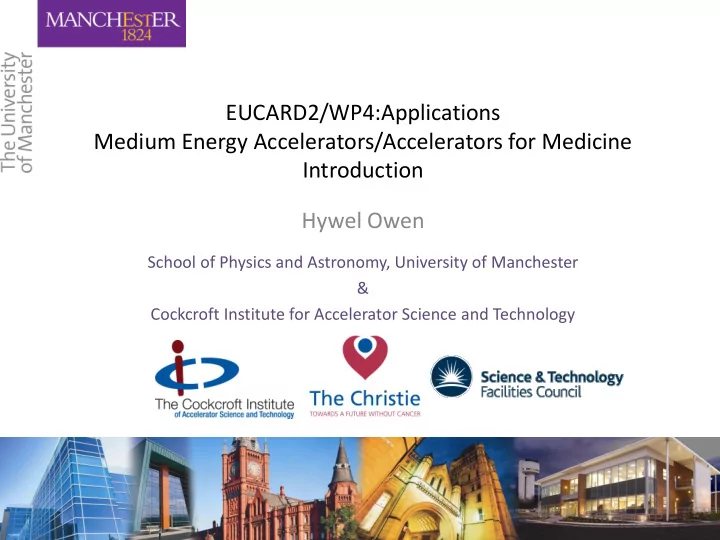

EUCARD2/WP4:Applications Medium Energy Accelerators/Accelerators for Medicine Introduction Hywel Owen School of Physics and Astronomy, University of Manchester & Cockcroft Institute for Accelerator Science and Technology
Area Application Beam Energy Number Applications Healthcare Radiotherapy for cancer X-ray <20 MeV >7500 Proton 250 MeV 32 Carbon 4800 MeV 4 Neutron keV UD PET isotopes and radioactive tracers Proton <100 MeV >200 Energy production Safer reactors & waste transmutation Proton ~1 GeV 1 UD Fusion Ions Various UD Environment Pollutants from chimneys Electrons 0.8 MeV UD Water treatment Electrons 5 MeV Industrial Cross-linking materials Electron <10 MeV Medical sterilization Electron <10 MeV 1700 Bio-fuels from non-edible starch Electron 1 MeV Ion implantation Ions 0.5 MeV 10000 Elemental analysis Ions ~1 MeV 100 Security Cargo screening Neutrons <10 MeV UD Protons < 10 GeV UD X-rays MeV UD Muons ~1 GeV UD Neutron spallation Materials through interactions with nuclei Protons <2 GeV 5 Light sources Materials through electron interactions Electrons Few GeV 60
Radiotherapy Statistics for UK • ‘Radiotherapy Services in England 2012’, DoH – 130,000 treatments, most common age around 60 yrs – 2.5 million attendances – More than half of attendances are breast/prostate • X-rays – 265 linacs in clinical use – Almost all machines IMRT-enabled, 50% IGRT (Image-Guided) – Each machine does >7000 ‘attendances’ – 147 more linacs required due to increasing demand • Protons – 1 centre (Clatterbridge) • Cancer care – 40% curative treatments utilise radiotherapy – 16% cured by radiotherapy alone
Proton Therapy Siting • The primary focus in the UK: development of proton therapy accelerators • 2 New UK Centres for Proton Therapy – Christie Hospital (Manchester) – UCL Hospital (London) – Choice made on basis of oncology expertise, critical size, and location cf. patient load ‘The facility should go where the patients are and where the clinical strength is’ – Stuart Green, UHB Compressed sites + throughput + cost = compact gantries, low cost machines
Some provocative statements • Much applied accelerator technology is old, therefore unexciting – We should not work in established technology, e.g. linacs – We should work on either: – Near-term big improvements to emerging technology • e.g. better proton/carbon machines, e.g. FFAGs, RCS – Longer-term technology shifts • E.g. plasma, dielectric, metamaterials • New entrants to market must provide product which is significantly better, not just equally capable – Size matters!!! • Industry is more concerned at providing equipment with lower cost (including for example, rather than with greater capability, unless customer demands it – Example: proton therapy • Networking seen as very important in catalysing technology transfer
My view of priority areas where we can contribute • • Monte Carlo e.g. GEANT4 Rapid-varying energy (size crucial) – – Coupling to beam transport, FFAG – Rapid-cycling synchrotron BDSIM – Cyclinac – Faster calculations – Better nuclear models • Compact technologies – Better beam models in treatment – Dielectric wall accelerators planning – Metamaterials • Imaging technologies/diagnostics – Plasma – Proton tomography – Gradient is crucial – Secondary particle imaging – Use of silicon detector tech. • Radiobiology • Gantry design – European facility essential – Superconducting dipoles – FFAG gantries • Use of other particles – Spot scanning – Helium? – Test stand?
Some SC Gantry Pictures (both Pavlovic optics) CEA/IBA 3.3 T for 425 MeV/u 150 t structure NIRS (Japan) 210 t total 3.0 T for 430 MeV/u 200 t total 13.5 m x 4 m 13 m x 5.5 m 1mm deformation 1cm isocentre stability
FFAG Gantries (Trbojevic, BNL) 4.1 m 8.6 m 20.8 Carbon E k =400 MeV/u B r = 6.35 Tm ( q = Bl/B r ) B=1.6 T then r ~ 4.0 m Warm iron magnets: B=3.2 T then r ~ 2.0 m Superconducting magnets
Put the cyclotron on the gantry?
The required size of new technology Gradient + quality + clean
The required size of new technology
Radioisotope Production – 1 Page Summary • Can divide isotope needs into 4 groups: 2. Conventional PET/SPECT isotopes (18F, 82Rb, I-123, 201Tl, 111In) – Currently met by domestic cyclotrons 1. Technetium-99m (SPECT) (c. 18 MeV) – Reactor-based supply (235U(n,f)) – Some interest in compact cyclotrons – Ongoing supply threat (c. 9 MeV) (STFC workshop) – New European reactor best option, but – Perhaps development of compact FFAGs? expensive – Accelerator-based methods possible, but 3. Brachytherapy/radionuclidic therapy isotopes limited activity – I-131, Ir-192, Pd-103 from cyclotrons – Use of FETS/other test stands? (Direct – 100Mo(p,2n) Lots of research/clinical interest in alpha- only emitters – Use of Laser-proton acceleration • e.g. Radium-223 Chloride – Electron linacs? (100Mo(g,n) – Relatively unexplored by accelerator community • 2x STFC/CI workshops held, 2011 and 2012 4. Exotic imaging/therapy isotopes • National UK isotope working group established – 61Cu, 62Cu, Tc94m, Mn52m, In110, etc. – Reviewing options – Number of isotopes already sold, e.g. AAA – No central facility development, spinout from CERN/Rubbia commercial only!
Recommend
More recommend